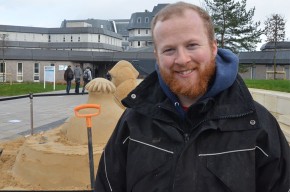Forget sandcastles – it’s all about sand-camels!
Posted on Wednesday, February 6 2013

A Bournemouth University graduate who has travelled the world making amazing sand and ice sculptures was back on campus to create a giant sand-camel.
Jamie Wardley was back on Talbot Campus to create a giant sand sculpture of NeSSa the Camel, as part of the campaign to encourage final year students to fill out the National Student Survey (NSS).
Jamie graduated from the BSc (Hons) Environmental Protection degree course in 2001, and has since set up his own company – Sand In Your Eye – which is based in his hometown of Bradford, creating sand and ice sculptures and large-scale sand drawings.
He said: “I first got interested in sand sculpting in 1998, so when I was at uni, I was always down on the beach practising.
“The degree that I did was very useful. You wouldn’t necessarily think it with me being a sand sculptor, but we covered things like law and project management and health and safety and all of those things which are really important when you are running a business.”
Since graduating from BU, Jamie has travelled the world making his sculptures and drawings, and even helped Aardman Animations create the world’s largest stop-motion animation set, which featured his sand drawings.
Jamie, 33, said: “I have been all over Europe, Columbia, Georgia, Sweden – all over the world.
“My favourite sculpture was of Charles Darwin in Bradford – it was five metre long and 120 metres high. It was nice because it was my hometown.”
But, he said, it was nice to be back at BU, to create the giant sand-camel in the courtyard area of Talbot Campus.
The sculpture – which Jamie worked on for two days – features BU’s NSS mascot NeSSa the Camel in a dinghy boat, as part of this year’s seaside-themed campaign.
Jamie said: “It is lovely to be back in Bournemouth – I hadn’t been back to the university since I left so it’s really nice, and I even bumped into one of my own lecturers.
“The students have all been stopping and seem really interested in the sculpture. They seemed to recognise it really early on.”
He added that top tips for any budding sand-sculptors included lots of practice and plenty of water.
“I had a natural flair for it, but you are always learning and getting better.
“There are all these theories about the amount of sand that you need to use, but it’s all about techniques. Basically, you just need to use lots of water – especially if you are on a beach.”
 Bournemouth University
Bournemouth University